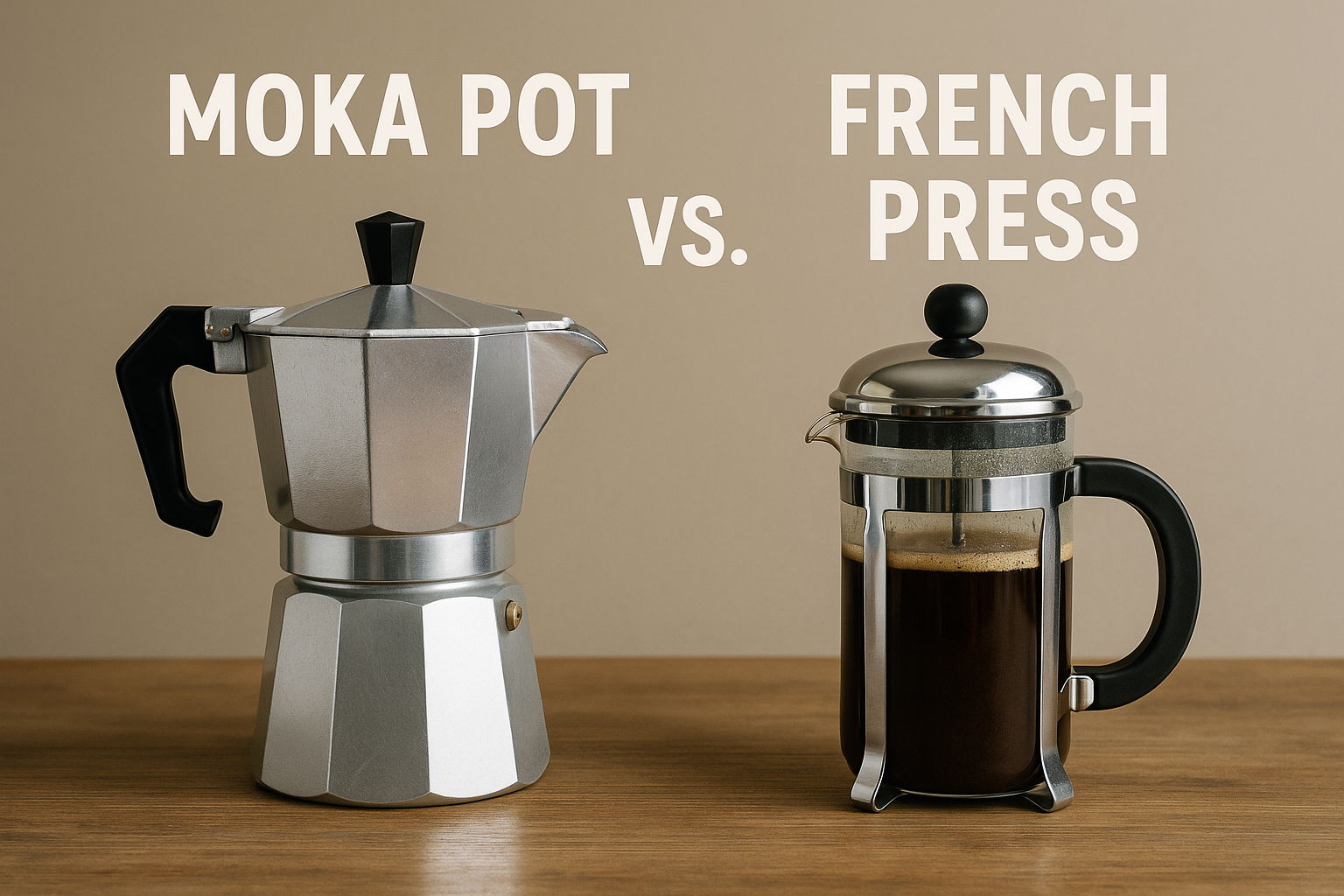Two of the most iconic and accessible coffee brewing methods are the Moka Pot and the French Press.
Whether you’re just beginning your coffee journey or trying to improve your morning routine, choosing between these two brewing devices can shape your coffee experience.
Both methods are manual, budget-friendly, and offer strong, flavorful coffee. But they differ greatly in taste, texture, caffeine content, ease of use, and maintenance. This comprehensive comparison will help you decide which one suits your preferences, lifestyle, and coffee goals.
What Is a Moka Pot?
The Moka Pot, also known as a stovetop espresso maker, was invented in Italy in 1933 by Alfonso Bialetti. It brews coffee by passing boiling water pressurized by steam through ground coffee.
Despite the term “stovetop espresso,” it doesn’t create real espresso. However, it produces a strong, rich brew with an intensity that’s close — especially compared to drip or pour-over coffee.
How it works:
- Fill the bottom chamber with water.
- Add ground coffee to the filter basket.
- Heat on the stove.
- Steam pressure pushes water through the grounds into the upper chamber.
What Is a French Press?
The French Press (also called a cafetière or press pot) is a classic immersion brewer. Instead of forcing water through grounds, it soaks the coffee in hot water for several minutes, then uses a plunger to separate the grounds.
Invented in the 1920s and loved for its simplicity, the French Press is especially popular among fans of bold, full-bodied coffee.
How it works:
- Add coarse-ground coffee to the carafe.
- Pour hot water and stir.
- Let it steep (usually 4 minutes).
- Press the plunger down slowly.
Comparing Taste and Texture
Moka Pot:
- Taste: Strong, sharp, concentrated — similar to espresso but slightly more bitter.
- Texture: Less oily, more refined.
- Best for: People who enjoy bold, intense coffee and espresso-like drinks (e.g., cappuccino, latte).
French Press:
- Taste: Full-bodied, smooth, rich, often more aromatic.
- Texture: Heavier mouthfeel due to natural coffee oils and micro-grounds.
- Best for: Those who enjoy deep, round flavors and a thicker brew.
Grind Size & Type of Coffee
Moka Pot:
- Grind size: Fine to medium-fine (finer than drip, but not as fine as espresso).
- Beans: Medium to dark roast works best due to lower acidity and fuller body.
French Press:
- Grind size: Coarse (similar to kosher salt).
- Beans: Medium to light roast for more nuanced flavor; dark roast for boldness.
🔍 Tip: Using the wrong grind size can result in over-extraction or clogging (Moka Pot) or sediment-heavy, bitter brews (French Press).
Brewing Time and Effort
Moka Pot:
- Time: 5–7 minutes (depending on stove and heat level).
- Effort: Moderate — needs close attention and careful timing to avoid burning.
French Press:
- Time: 4 minutes steeping, plus prep.
- Effort: Minimal — set it and forget it until pressing.
Ease of Use for Beginners
Moka Pot:
- Requires more attention to detail.
- Risk of burning the coffee if left on too long.
- Needs experience to control heat and timing.
French Press:
- Extremely beginner-friendly.
- Easy to replicate with consistent results.
- Forgiving method — perfect for casual users.
Verdict: If you’re new to coffee, the French Press is more forgiving and easier to master.
Cleaning and Maintenance
Moka Pot:
- Needs to be disassembled and rinsed after each use.
- Aluminum models can stain over time; stainless steel lasts longer.
- Must dry thoroughly to prevent corrosion.
French Press:
- Easy to clean, but the mesh filter needs occasional deep cleaning.
- Dishwasher-safe models available.
Winner: French Press. Simpler design and fewer parts mean easier cleanup.
Price Comparison
| Device | Average Price | Durability | Maintenance |
|---|---|---|---|
| Moka Pot | $25 – $45 | Long-lasting (metal) | Medium |
| French Press | $20 – $40 | Can break if glass | Easy |
Note: Stainless steel French presses are more expensive ($45+), but nearly indestructible.
Caffeine Content: Which One Packs More Punch?
- Moka Pot: 60–100 mg per 2 oz (stronger per ounce, smaller servings)
- French Press: 80–100 mg per 8 oz (milder per ounce, larger cup)
The Moka Pot is more concentrated, so a single cup hits harder — but you drink less of it. The French Press offers a larger volume, with smooth caffeine delivery.
Portability and Travel Use
Moka Pot:
- Compact and durable
- No filters needed
- Works best with a heat source (gas, electric, or portable stove)
French Press:
- More fragile (unless stainless steel)
- Requires hot water source
- Available in travel-friendly designs (e.g., insulated mugs with plunger)
Environmental Impact
Both are eco-friendly, especially when compared to single-use pods or paper-filter methods.
- Moka Pot: No disposable parts. Entirely reusable.
- French Press: Mesh filter eliminates paper waste.
For sustainability-minded users, both are solid options.
Common Beginner Mistakes
With the Moka Pot:
- Grinding beans too fine (leads to clogging or bitter taste)
- Overheating (causes burnt coffee)
- Not sealing parts tightly
With the French Press:
- Using fine grounds (results in muddy coffee)
- Pressing too fast (causes splashing or resistance)
- Not cleaning the filter regularly
Which One Should You Choose?
It depends on your coffee personality:
| Preference | Best Option |
|---|---|
| Strong, espresso-style coffee | Moka Pot |
| Rich, smooth, full-bodied coffee | French Press |
| Easy cleanup & use | French Press |
| Compact for travel | Moka Pot (aluminum) |
| Lower acidity | French Press |
| Creamy coffee drinks (e.g., lattes) | Moka Pot |
| Want to experiment with technique | Moka Pot |
| Want a reliable, no-fuss brew | French Press |
Frequently Asked Questions (FAQs)
Q: Can I use the same coffee beans in both?
A: Yes, but grind size should be adjusted accordingly. The same beans can produce very different results depending on how they’re brewed.
Q: Is one method healthier than the other?
A: French Press retains more coffee oils, which can slightly raise cholesterol levels if consumed excessively. Moka Pot filters some oils but not all. For most people, both are perfectly fine.
Q: Can I make espresso with a Moka Pot?
A: Not true espresso — Moka Pot doesn’t generate enough pressure (needs 9 bars). But it comes close in flavor strength.
Q: Does one method waste more coffee?
A: French Press generally uses more coffee due to its immersion style. Moka Pot is more efficient per ounce of strong brew.
Final Thoughts: Choose Based on Your Coffee Lifestyle
At the end of the day, both the Moka Pot and the French Press are excellent tools for brewing high-quality coffee at home. They’re affordable, eco-friendly, and bring a satisfying ritual to your morning routine.
- If you love strong, bold, intense coffee and want to try milk-based drinks, go with the Moka Pot.
- If you prefer rich, smooth, full cups with less hassle, the French Press is your best friend.
Better yet? Try both and enjoy the range of flavors each one unlocks.

